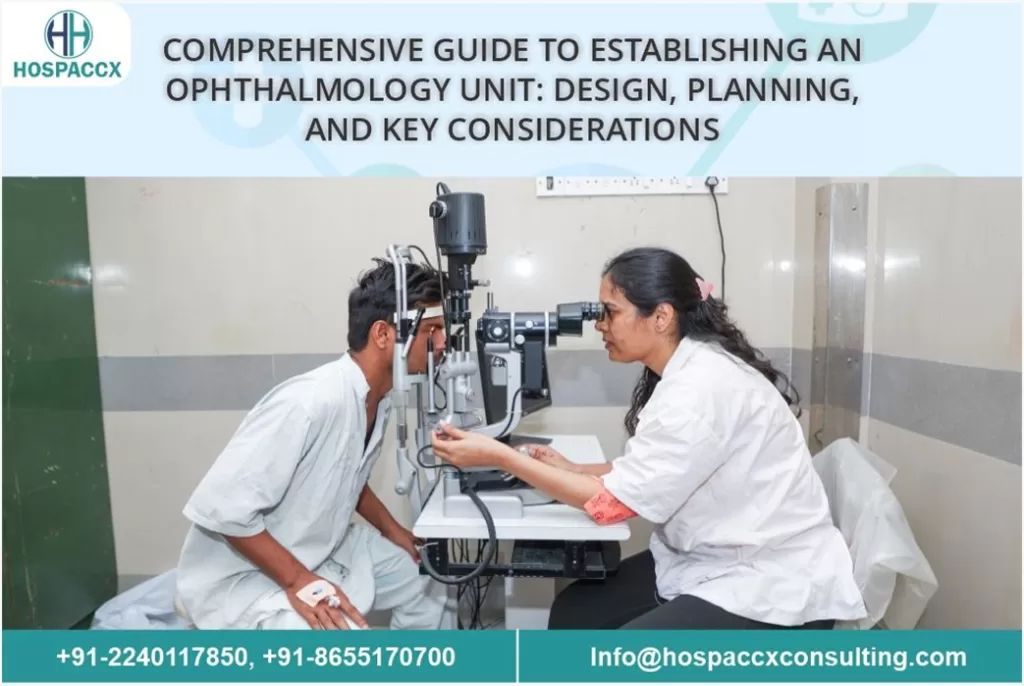Establishing a well-equipped ophthalmology unit is essential for delivering high-quality eye care services to patients. Whether you’re setting up a unit within a hospital, a private clinic, or a dedicated eye center, a well-designed ophthalmology unit ensures the highest standard of patient care. From diagnostics and treatment to surgical procedures, an ophthalmology unit must be optimized for efficiency, safety, and comfort. This detailed guide covers all the essential aspects of planning, designing, and establishing an ophthalmology unit, including infrastructure, equipment, staffing, and regulatory considerations.
Assessing the Scope of Services and Market Demand
Before designing your ophthalmology unit, a thorough analysis of the scope of services and market demand is essential:
- Scope of Services: Determine whether the unit will focus on primary eye care, diagnostic services, surgery (e.g., cataract surgery, LASIK), or a comprehensive offering that includes medical, surgical, and post-operative care.
- Target Audience: Analyze the demographics and specific needs of the community or region you plan to serve. Understand the prevalence of eye diseases and disorders such as cataracts, glaucoma, macular degeneration, and refractive errors.
- Partnerships: Consider establishing connections with general practitioners, local hospitals, and health clinics to refer patients to your unit.
Planning and Feasibility Study
A solid feasibility study is crucial to understand the operational, financial, and regulatory aspects of establishing the ophthalmology unit:
- Market Research: Study the demand for eye care services in your area. Assess competition, identify gaps in services, and tailor your offerings accordingly.
- Budgeting: Plan for the costs involved, including equipment purchase, facility construction or renovation, staffing, marketing, and ongoing operational expenses. Include both capital expenditure and working capital needs.
- Licensing and Regulatory Compliance: Ensure compliance with local healthcare regulations and medical standards, including accreditation from relevant bodies such as the National Accreditation Board for Hospitals & Healthcare Providers (NABH).
Designing the Ophthalmology Unit
The design and layout of your ophthalmology unit should prioritize patient comfort, safety, and staff efficiency. Here are key considerations for designing an effective unit:
Core Areas in the Ophthalmology Unit
- Reception and Waiting Area: Design a spacious, welcoming reception area where patients can comfortably wait. This area should have easy access to registration counters and offer a calm environment with comfortable seating.
- Consultation Rooms: These rooms should be equipped with examination chairs, diagnostic instruments, and patient monitoring equipment. The layout should allow for easy movement of both patients and medical staff.
- Diagnostic Rooms: These should be designed to accommodate various diagnostic equipment such as slit lamps, tonometers, visual field analyzers, and fundus cameras. The rooms must be equipped with sufficient lighting, power outlets, and storage for tools and consumables.
- Surgical Suite: If your unit will offer surgery, design a sterile, well-equipped surgical area with an operating table, microscope, and surgical instruments. The room should be spacious enough for the surgical team to move around freely while ensuring the highest level of cleanliness and infection control.
- Recovery Area: Provide a comfortable and private space for patients to recover post-surgery or post-procedure. This area should be equipped with monitoring equipment and designed for ease of movement, ensuring quick access to emergency care if necessary.
- Specialized Treatment Rooms: Depending on your offerings, you may need specialized treatment rooms for therapies such as laser treatment, low vision rehabilitation, or optical fittings.
Design Features to Consider
- Efficient Workflow: Ensure a seamless flow between different areas of the unit, minimizing unnecessary movement and ensuring that patients are quickly and comfortably directed to the appropriate area.
- Privacy and Comfort: Patient comfort is paramount. Incorporate noise-reducing materials, ambient lighting, and private spaces for consultations and treatments. Use soundproofing in exam and recovery rooms to maintain a quiet, healing environment.
- Infection Control: Implement strict infection control measures, particularly in surgical areas. Use high-quality non-porous materials for flooring, walls, and furniture, ensuring easy cleaning and sterilization.
- Lighting: Proper lighting is crucial in ophthalmology. Ensure the space is well-lit with adjustable, bright lighting in examination areas. Use specialized lighting in diagnostic and surgical rooms to reduce eye strain and ensure accurate diagnoses.
- Accessible Design: Incorporate accessibility features such as ramps, elevators, and wide doorways for patients with mobility impairments.
Equipment and Technology for the Ophthalmology Unit
An ophthalmology unit requires specialized equipment to provide high-quality care. Invest in the following essential equipment:
- Diagnostic Equipment: This includes slit lamps, optical coherence tomography (OCT) machines, fundus cameras, and refraction machines to perform a wide range of eye exams.
- Surgical Equipment: For units offering surgical procedures, include advanced microscopes, phacoemulsification systems for cataract surgery, laser equipment for refractive surgery, and surgical instruments for corneal transplants or vitreoretinal surgeries.
- Visual Field Analyzers: For diagnosing conditions like glaucoma, visual field analyzers are critical in assessing the patient’s vision and detecting any abnormalities.
- Pharmaceuticals and Consumables: Stock the necessary pharmaceuticals, eye drops, surgical drapes, and consumables such as bandages and gloves.
Additionally, implement Electronic Health Records (EHR) systems for easy tracking of patient data, ensuring that medical records are organized, accessible, and compliant with healthcare data privacy regulations.
Staffing Requirements and Training
A well-trained, specialized team is essential for running a successful ophthalmology unit. Key personnel include:
- Ophthalmologists: Skilled eye specialists who diagnose and treat eye conditions, perform surgeries, and manage complex cases.
- Optometrists: Provide vision testing and prescribe corrective lenses, working closely with ophthalmologists to provide comprehensive care.
- Nurses: Trained nurses who assist with pre- and post-operative care, patient education, and managing day-to-day operations of the unit.
- Technicians: Operate diagnostic and surgical equipment, maintain records, and assist ophthalmologists during procedures.
- Administrative Staff: Handle patient scheduling, billing, and day-to-day operations of the unit.
- Support Staff: Including patient counselors, receptionists, and medical assistants, ensuring that patients are taken care of before, during, and after their visit.
Regular training programs should be conducted to ensure that all staff members stay updated on the latest technological advancements and best practices in ophthalmology.
Regulatory and Safety Considerations
Comply with local and international guidelines for ophthalmic care and safety:
- Medical Device Regulations: Ensure that all equipment is certified for use in healthcare settings and complies with local medical device regulations.
- Infection Control Protocols: Adhere to stringent infection control protocols, particularly in surgical and diagnostic areas, to prevent the transmission of infections.
- Patient Safety Standards: Establish protocols for patient safety, including preoperative assessments, sterile practices in surgical areas, and post-operative monitoring.
- Licensing and Accreditation: Obtain the necessary licenses for medical practice and ensure that your ophthalmology unit is accredited by relevant healthcare regulatory bodies.
Financial Planning and Budgeting
A comprehensive financial plan is essential for the sustainable operation of your ophthalmology unit:
- Initial Setup Costs: Account for the costs of construction, equipment purchase, and regulatory compliance.
- Operating Expenses: Factor in costs such as staff salaries, utilities, insurance, consumables, and equipment maintenance.
- Revenue Models: Identify potential revenue sources, including fees for consultations, surgeries, and diagnostic services, as well as insurance reimbursements and government subsidies.
Marketing and Patient Outreach
To attract patients and build a successful practice, implement a targeted marketing strategy:
- Referral Networks: Build relationships with general practitioners, pediatricians, and other healthcare providers to receive referrals.
- Community Engagement: Hold seminars, workshops, and screening camps to raise awareness about eye health and services offered by your unit.
- Digital Marketing: Use social media and your website to highlight patient success stories, share educational content, and promote your services.
Role of Hospaccx Healthcare Business Consulting
Hospaccx Healthcare Business Consulting plays an essential role in the successful establishment of your ophthalmology unit. Their expertise can support you through:
- Facility Design: Crafting an efficient, patient-friendly, and safe layout for your unit.
- Regulatory Compliance: Navigating the complex landscape of healthcare regulations, licensing, and accreditation.
- Operational Strategy: Streamlining operational processes to ensure high patient satisfaction and low wait times.
- Financial Planning: Helping with budget planning, cost management, and identifying revenue opportunities.
- Marketing and Branding: Supporting marketing strategies to build a strong brand and attract patients.
Hospaccx offers a holistic approach to setting up your ophthalmology unit, ensuring that every aspect—design, operations, compliance, and patient care—is optimized.
Conclusion
Establishing a successful ophthalmology unit requires careful planning, state-of-the-art equipment, specialized staff, and compliance with healthcare regulations. By focusing on thoughtful design, patient care, and operational efficiency, you can create a unit that provides high-quality eye care while meeting the needs of your community. With the expert guidance of Hospaccx Healthcare Business Consulting, your ophthalmology unit can become a leading provider of eye care services, offering both medical expertise and a patient-centered approach to healthcare.
#OphthalmologyCare #EyeHealth #HealthcareDesign #OphthalmologyUnit #PatientCare #EyeSurgery #HealthcareBusiness #OphthalmicCare #HospitalDesign #HospaccxCares #Ophthalmologist #VisionCare
Related Team Members




















